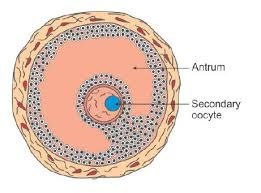Apply to Aakash iACST Scholarship Test 2024
NCERT Solutions for Class 12 Biology Chapter 3 Human Reproduction
NCERT Solutions for Class 12 Biology Chapter 3 Human Reproduction: As you know, humans are viviparous and reproduce sexually. The reproductive events in humans include the formation of gametes, which is called gametogenesis. That is, sperm in males and ovum in females; the transfer of sperm into the female genital tract (insemination); and fusion of male and female gametes (fertilisation) leading to the formation of a zygote. In solutions for NCERT Class 12 Biology Solutions Chapter 3, you will get solutions from implantation. For that, you should know that it is followed by the formation and development of the blastocyst and its attachment to the uterine wall (implantation), embryonic development (gestation), and delivery of the baby (parturition). The NCERT Solutions for Class 12 contain solutions provided by subject matter experts, and students can use these solutions to prepare for their board exams. Scroll down to go through the questions and answers given in NCERT Solutions for Class 12 Biology Chapter 3.

In Human Reproduction Class 12, you will also get interesting questions from the other topics for which you have to study the general principles about the reproductive processes in living organisms. Class 12 Biology Chapter 3 is curated according to the latest CBSE Syllabus for 2023-24. These Class 12 Biology NCERT Solutions will help students score well in the exams. Human Reproduction Class 12 Solutions provide explanation in detail with related and representative examples.
Chapter 3 Biology Class 12 are beneficial to enhance the conceptual knowledge of students. Human reproduction Class 12 will also help you to understand the concepts and topics fro the competitive exams as well. If you are looking for the answers of any other class from 6-12 then NCERT solutions are there for you as it's the easiest way to get all the solutions. As well as Human Reproduction Class 12 NCERT PDF can be downloaded.
NCERT Solutions For Class 12 Biology Human Reproduction
According to the latest CBSE Syllabus 2023-24, this chapter has been renumbered as Chapter 2.
Also Read,
- NCERT Notes for class 12 biology chapter 3 human reproduction
- NCERT Exemplar for class 12 biology chapter 3 human reproduction
NCERT Solutions for Class 12 Biology Chapter 3 Human Reproduction
NCERT solutions for human reproduction Class 12 are given below:
Human Reproduction Exercise:
(a) Humans reproduce _____________ (asexually/sexually)
(b) Humans are _____________ (oviparous, viviparous, ovoviviparous)
(c) Fertilisation is _____________ in humans (external/internal)
(d) Male and female gametes are _____________ (diploid/haploid)
(e) Zygote is _____________ (diploid/haploid)
(f) The process of release of ovum from a mature follicle is called _____________
(g) Ovulation is induced by a hormone called _____________
(h) The fusion of male and female gametes is called _____________
(i) Fertilisation takes place in _____________
(j) Zygote divides to form _____________which is implanted in uterus.
(k) The structure which provides vascular connection between foetus and uterus is called _____________
Answer:
(a) Humans reproduce sexually
(b) Humans are viviparous
(c) Fertilisation is internal in humans
(d) Male and female gametes are haploid
(e) Zygote is diploid
(f) The process of release of ovum from a mature follicle is called ovulation
(g) Ovulation is induced by a hormone called luteinizing hormone
(h) The fusion of male and female gametes is called fertilisation
(i) Fertilisation takes place in a fallopian tube
(j) Zygote divides to form a blastocyst which is implanted in the uterus.
(k) The structure which provides vascular connection between foetus and uterus is called placenta
Q2. Draw a labelled diagram of male reproductive system.
Answer:
Labelled diagram of the male reproductive system human reproduction class 12 is as follows:
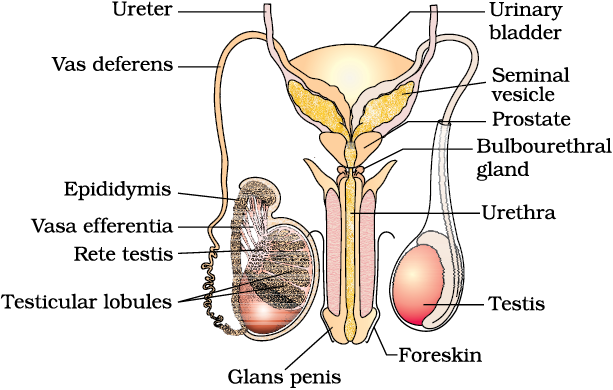
Human Reproduction Class 12 Solutions
Q3. Draw a labelled diagram of female reproductive system.
Answer:
Female reproductive system

Q4. Write two major functions each of testis and ovary.
Answer:
Functions of testis
- Testis produces spermatozoa which are male gametes.
- In testis, the male sex hormone testosterone is developed.
Functions of ovary
- The ovary produces ovum by the process oogenesis.
- Graffian follicles in ovary produce female sex hormone called estrogen.
Human Reproduction Class 12 NCERT Solutions
Q5. Describe the structure of a seminiferous tubule.
Answer:
Seminiferous tubules are highly coiled structures present in testicular lobules. The seminiferous tubules are lined by two types of cells i.e. spermatogonia and Sertoli cells from inside. Spermatogonia are the male germ cells that form sperms through meiotic divisions followed by mitotic division, while Sertoli cells provide nutrition to the germ cells. The regions outside the seminiferous tubules called is called the interstitial space and it contains small blood vessels and Leydig cells. TheLeydig's cells secrete androgens.
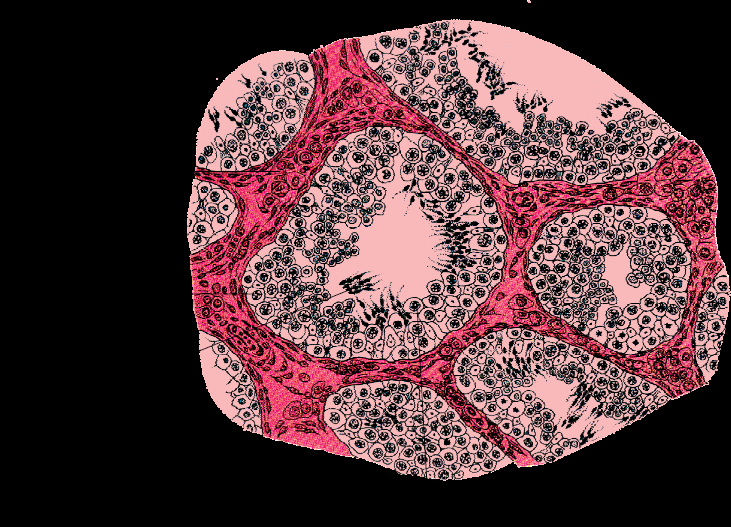
Q6 What is spermatogenesis? Briefly describe the process of spermatogenesis.
Answer:
Spermatogenesis- It is the process of formation of spermatozoa from spermatogonia in testes at the time of puberty is called spermatogenesis. In this process, the spermatogonia present at the inner side of seminiferous tubules multiply by mitotic division and increase in number. Each spermatogonium contains 46 chromosomes. Spermatogonia forms spermatocyte that undergoes meiotic division to produce secondary spermatocytes having 23 chromosomes. The secondary spermatocytes undergo 2nd meiotic division to form spermatids. The spermatids are transformed into spermatozoa by the process called spermiogenesis . The sperm heads remain embedded in the Sertoli cells and are released from seminiferous tubules by the process of spermiation

Human Reproduction Class 12 Solutions:
Q7. Name the hormones involved in regulation of spermatogenesis.
Answer:
Spermatogenesis initiated due to an increase in the secretion of gonadotropin-releasing hormone by the hypothalamus. Increase in GnRH act on anterior pituitary and stimulate secretion of two gonadotropins, LH (luteinizing hormone) and FSH (follicular stimulating hormone). Among these, LH acts on Leydig cells and stimulates them to secrete androgens whereas FSH acts on Sertoli cells and stimulates the secretion of some factors which help in spermiogenesis.
Q8. Define spermiogenesis and spermiation.
Answer:
Spermiogenesis- The spermatids are transformed into spermatozoa by the process called spermiogenesis .
Spermiation- The release of sperms from the seminiferous tubules occurs through a process called spermiation.
Human Reproduction Class 12 NCERT Solutions:
Q9. Draw a labelled diagram of sperm.
Answer:
Labelled diagram of human sperm is as follows:
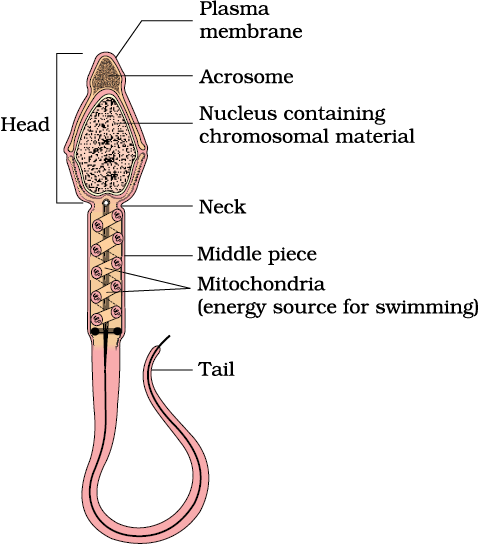
Q10. What are the major components of seminal plasma?
Answer:
The major components of seminal plasma are mucous, fructose, calcium, ascorbic acid, certain enzymes and some secretions of accessory glands.
Class 12 Biology Chapter 3 Question Answer
Q11. What are the major functions of male accessory ducts and glands?
Answer:
Male accessory ducts include vasa efferentia, epididymis. vas deferens and rete testis. THey transport and temporarily store spermatozoa. Male accessory glands include seminal vesicle, bulbourethral gland and prostate gland. These glands secrete fluids that lubricate the female reproductive system and sperms.
Q12 . What is oogenesis? Give a brief account of oogenesis.
Answer:
The process of formation of mature female gametes is called oogenesis. It starts during embryonic development stage when millions of oogonia (gamete mother cells) are formed in each fetal ovary. The gamete mother cells start division and enter into prophase-I of meiotic division and get temporally arrested. At this stage, they are called primary oocytes . Each primary oocyte gets surrounded by a layer of granulosa cell than it is called the primary follicle . The primary follicle gets surrounded by more layers of granulosa cells called secondary follicle that transform into tertiary follicle that contains a fluid filled cavity called antrum. The tertiary follicles further change into the mature follicle called Graafian follicle , which rapture to release secondary oocytes (ovum) from the ovary by the process of ovulation.
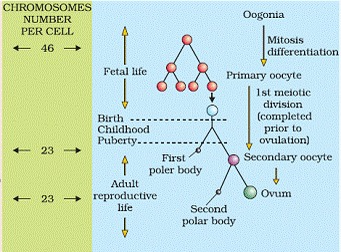
Class 12 Biology Chapter 3 NCERT Solutions
Q13 . Draw a labelled diagram of a section through ovary.
Answer:
A labelled diagram of a section through the ovary is as follows:
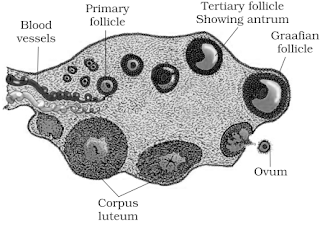
Class 12 Biology Chapter 3 Question Answer:
Q15. Name the functions of the following:
Answer:
Corpus luteum-
It secretes progesterone. Progesterone is essential for the maintenance of endometrium.
Answer:
Endometrium- Implantation of the fertilized ovum and many events of pregnancy takes place in the endometrium.
Answer:
Acrosome- It is filled with enzymes that hydrolyse egg membrane thus, helping the sperm in penetration of ovum during fertilisation of the ovum.
Class 12 Biology Chapter 3 NCERT Solutions:
Q16. Identify True/False statements. Correct each false statement to make it true.
(a) Androgens are produced by Sertoli cells. (True/False)
Answer:
Androgens are produced by Sertoli cells. (False).
Androgens are produced by Leydig's cells
(b) Spermatozoa get nutrition from Sertoli cells. (True/False)
Answer:
Spermatozoa get nutrition from Sertoli cells. (True)
(c) Leydig cells are found in ovary. (True/False)
Answer:
Leydig cells are found in ovary. (False)
Leydig cells are found in seminiferous tubules of testis
(d) Leydig cells synthesise androgens. (True/False)
Answer:
Leydig cells synthesise androgens. (True)
(e) Oogenesis takes place in corpus luteum. (True/False)
Answer:
Oogenesis takes place in corpus luteum. (False)
Oogenesis takes place in ovary
Answer:
Presence or absence of hymen is not a reliable indicator of virginity or sexual experience. (True)
Class 12 Human Reproduction NCERT Solutions
Q17 . What is menstrual cycle? Which hormones regulate menstrual cycle?
Answer:
Menstrual cycle: The reproductive cycles in female primates is called the menstrual cycle. In a 28 days menstrual cycle, the menses takes place on cycle days 3-5. The menstrual cycle consists of phases like menstrual phase, follicular phase, ovulatory phase and luteal phase.
Menstrual phase
1. The production of LH from the anterior lobe of the pituitary gland is reduced.
2. The withdrawal of this hormone causes degeneration of the corpus luteum and, therefore progesterone production is reduced.
3. Production of oestrogen is also reduced in this phase.
4. The endometrium of the uterus breaks down & menstruation begins.
5. The cells of endometrium secretions, blood & unfertilised ovum constitute the menstrual flow.
Follicular phase-
1. This phase usually includes cycle days 6-13 or 14 in a 28 days cycle.
2. The follicle stimulating hormone (FSH) secreted by the anterior lobe of the pituitary gland stimulates the ovarian follicle to secrete oestrogens.
3. Oestrogen stimulates the proliferation of the endometrium of the uterine wall.
4. The endometrium becomes thicker by rapid cell multiplication and this is accompanied by an increase in uterine glands & blood vessels.
Ovulatory phase
1. Both LH & FSH attain a peak level in the middle of the cycle (about 14 th day).
2. Oestrogen concentration in blood increases.
3. Rapid secretion of LH induces rupturing of the graffian follicle and thereby the release of the ovum. In fact, LH causes ovulation.
Luteal Phase:
1. Includes cycle days 15 to 28.
2. Corpus luteum secretes progesterone.
3. Endometrium thickens.
4. Uterine glands become secretory.
Hormonal control of the menstrual cycle.
1. FSH stimulates the ovarian follicles to produce oestrogens.
2. LH stimulates corpus luteum to secrete progesterone.
3. Menstrual phase is caused by the increased production of oestrogens.
4. LH causes ovulation
5. The proliferative phase is caused by the increased production of oestrogens.
6. The secretory phase is caused by increased production of progesterone.
Human Reproduction Class 12 Questions and Answers
Q18. What is parturition? Which hormones are involved in induction of parturition?
Answer:
The process of delivery of the foetus is called parturition. Oxytocin hormone causes a strong contraction of uterine. Contraction of uterine becomes stronger and stronger by the stimulatory reflex between uterine contraction and oxytocin secretion. This leads to the expulsion of the baby out of the uterus through the birth canal.
Answer:
The sex chromosome in human female is XX while in a male it is XY. Thus, female produces haploid gametes having all X chromosomes but male produces two types of gametes with either X or Y. The sex of the child will be dependent on which sperm whether the one with X chromosomes or the one with Y chromosome fertilises the ovum with X chromosome. Therefore, the sex of the baby is determined by the father's chromosomes, not the mother's.
Class 12 Human Reproduction NCERT Solutions:
Answer:
One ovum is released by a human ovary in a month. Identical twins are developed from a single egg. Hence, only one egg would have been released when the mother gave birth to identical twins. If the twins are fraternal twins then they must have been developed from two eggs.
Q21. How many eggs do you think were released by the ovary of a female dog which gave birth to 6 puppies?
Answer:
Dogs are polyovulatory animals and they release more than one egg at a particular time. So, a female dog with 6 puppies in one generation, releases 6 eggs.
NCERT Solutions for Class 12 Biology Chapter 3 Human Reproduction
In CBSE NCERT Solutions for Human Reproduction Class 12, there are questions from the sub-topic puberty also so, you have to learn that these reproductive events occur after puberty. as given in Ch 3 Biology Class 12, there are remarkable differences between the reproductive events in the male and in the female, for example, sperm formation continues even in old men, but the formation of ovum ceases in women around the age of fifty years. you will learn more in Biology Chapter 3 Class 12.
After going through this chapter of NCERT Solutions for Class 12 Biology line by line, you must have understood all the concepts have been covered in human reproduction Class 12 NCERT PDF. Now for your practice, use solutions for NCERT solutions for Class 12 biology chapter 3. Also try to solve all the questions which are mentioned at the end of Chapter 3 Biology Class 12 and if you need any help for the correct answer then, NCERT solutions for Class 12 biology chapter 3 human reproduction which is mentioned in the above would be helpful.
According to the previous year question papers, Human reproduction Class 12 NCERT comes under the unit reproduction that carries 14 marks for board exam. Hence, Class 12th students are required to focus on the chapter and understand it thoroughly to score well in the upcoming board exam.
Important topics of Human Reproduction Class 12 Solutions are given below:
Important topics from Class 12 Biology Chapter 3 are given below:
Section Name | Topic Name |
| 3 | Human Reproduction |
| 3.1 | The Male Reproductive System |
| 3.2 | The Female Reproductive System |
| 3.3 | Gametogenesis |
| 3.4 | Menstrual Cycle |
| 3.5 | Fertilisation and Implantation |
| 3.6 | Pregnancy and Embryonic Development |
| 3.7 | Parturition and Lactation |
| 3.8 | Summary |
JEE Main Important Mathematics Formulas
As per latest 2024 syllabus. Maths formulas, equations, & theorems of class 11 & 12th chapters
Highlights of NCERT Solutions Class 12 Biology Chapter 3 Human Reproduction
The biology subject experts provide human reproduction Class 12 NCERT solutions.
Important topics are listed in Chapter 3 Biology Class 12 NCERT solutions.
The questions and answers are written in the best possible way using simple language that makes Solutions of Biology class 12 chapter 3 easier to read and understand
Human reproduction NCERT solutions strengthen your fundamentals.
Diagrams have been used in Class 12 Biology Chapter 3 PDF to make concepts clear.
Human reproduction Class 12 Solutions are also helpful for competitive exams.
Human reproduction Class 12 NCERT PDF download links are readily available and easily accessible for free.
Also Check NCERT Books and NCERT Syllabus here:
- NCERT Books Class 12 Biology
- NCERT Syllabus Class 12 Biology
- NCERT Books Class 12
- NCERT Syllabus Class 12
NCERT Solutions for Class 12 Biology- Chapter wise
Chapter 1 | |
Chapter 2 | |
Chapter 4 | |
Chapter 5 | |
Chapter 6 | |
Chapter 7 | |
Chapter 8 | |
Chapter 9 | |
Chapter 10 | |
Chapter 11 | |
Chapter 12 | |
Chapter 13 | |
Chapter 14 | |
Chapter 15 | |
Chapter 16 |
NCERT Solutions for Class 12- Subject wise
NCERT Solutions for Class 12 Biology |
NCERT Exemplar Class 12 Solutions
NCERT Exemplar Class 12 Biology Solutions |
We hope you will ace your board examination with the help of NCERT Solutions for Class 12 Biology Chapter 3 Human Reproduction.
Frequently Asked Question (FAQs)
The important points of the male reproductive system given in human reproduction class 12 are:
Male Reproductive System-
- The male reproductive system is composed of a pair of testes, the male sex accessory ducts and the accessory glands and external genitalia.
- Each testis has about 250 compartments called testicular lobules, and each lobule contains one to three highly coiled seminiferous tubules.
- Each seminiferous tubule is lined inside by spermatogonia and Sertoli cells.
- The spermatogonia undergo meiotic divisions leading to sperm formation, while Sertoli cells provide nutrition to the dividing germ cells.
The important points of the female reproductive system given in human reproduction class 12 are:
Female Reproductive System-
- The female reproductive system consists of a pair of ovaries, a pair of oviducts, a uterus, a vagina, external genitalia, and a pair of mammary glands.
- The ovaries produce the female gamete (ovum) and some steroid hormones (ovarian hormones).
- Ovarian follicles in different stages of development are embedded in the stroma.
- The oviducts, uterus and vagina are female accessory ducts.
- The uterus has three layers namely perimetrium, myometrium and endometrium.
These are the important topics of NCERT solutions for class 12 biology chapter 3 Human Reproduction:
- The Male Reproductive System
- The Female Reproductive System
- Gametogenesis
- Menstrual Cycle
- Fertilization and Implantation
- Pregnancy and Embryonic Development
- Parturition and Lactation
If you have any doubt, or unable to solve the question mentioned in the NCERT then go through the NCERT solutions for class 12 biology chapter 3 human reproduction. It will help you to understand the concept behind the questions and also help you to prepare for a competitive exam (NEET) along with your school exam, as NCERT is the base for any kind of exam. NCERT solutions for class 12 biology chapter 3 human reproduction will also help you to prepare for 12th board exam. you can read them offline anytime, anywhere by downloading the pdf.
To score Wel in the examination, follow the NCERT syllabus and the exercise given in the NCERT Book. To practice problems, the NCERT exemplar is always helpful.
Also Read
Articles
Upcoming School Exams
Late Fee Application Date:22 July,2024 - 31 July,2024
Late Fee Application Date:22 July,2024 - 31 July,2024
Certifications By Top Providers
Explore Top Universities Across Globe
Questions related to CBSE Class 12th
hello mahima,
If you have uploaded screenshot of your 12th board result taken from CBSE official website,there won,t be a problem with that.If the screenshot that you have uploaded is clear and legible. It should display your name, roll number, marks obtained, and any other relevant details in a readable forma.ALSO, the screenshot clearly show it is from the official CBSE results portal.
hope this helps.
Hello Akash,
If you are looking for important questions of class 12th then I would like to suggest you to go with previous year questions of that particular board. You can go with last 5-10 years of PYQs so and after going through all the questions you will have a clear idea about the type and level of questions that are being asked and it will help you to boost your class 12th board preparation.
You can get the Previous Year Questions (PYQs) on the official website of the respective board.
I hope this answer helps you. If you have more queries then feel free to share your questions with us we will be happy to assist you.
Thank you and wishing you all the best for your bright future.
Hello student,
If you are planning to appear again for class 12th board exam with PCMB as a private candidate here is the right information you need:
- No school admission needed! Register directly with CBSE. (But if you want to attend the school then you can take admission in any private school of your choice but it will be waste of money)
- You have to appear for the 2025 12th board exams.
- Registration for class 12th board exam starts around September 2024 (check CBSE website for exact dates).
- Aim to register before late October to avoid extra fees.
- Schools might not offer classes for private students, so focus on self-study or coaching.
Remember
, these are tentative dates based on last year. Keep an eye on the CBSE website ( https://www.cbse.gov.in/ ) for the accurate and official announcement.
I hope this answer helps you. If you have more queries then feel free to share your questions with us, we will be happy to help you.
Good luck with your studies!
Hello Aspirant , Hope your doing great . As per your query , your eligible for JEE mains in the year of 2025 , Every candidate can appear for the JEE Main exam 6 times over three consecutive years . The JEE Main exam is held two times every year, in January and April.
Hi there,
Hope you are doing fine
Yes you are certainly eligible for giving the jee exam in the year 2025. You must pass the maths exam with at least 75% criteria as required by jee and provide the marksheet and the passing certificate while registering for the exam.
Pursuing maths as an additional subject while taking biology as your main subject does not offer any hindrance in you appearing for the jee examination. It is indeed an privilege to pursue both maths and biology as the subjects and prepare for the same.
There will be no issue in filling the form while registering for the exam as it will only require your basic details and marksheet which you can provide by attaching the marksheet of maths also. Also, a detailed roadmap is also available on the official websites on how to fill the registration form. So you can fill the form easily.
Hope this resolves your query.
Popular CBSE Class 12th Questions
Colleges After 12th
Applications for Admissions are open.

Tallentex 2025 - ALLEN's Talent Encouragement Exam
ApplyRegister for Tallentex '25 - One of The Biggest Talent Encouragement Exam

Aakash iACST Scholarship Test 2024
ApplyGet up to 90% scholarship on NEET, JEE & Foundation courses

JEE Main Important Chemistry formulas
ApplyAs per latest 2024 syllabus. Chemistry formulas, equations, & laws of class 11 & 12th chapters

JEE Main Important Physics formulas
ApplyAs per latest 2024 syllabus. Physics formulas, equations, & laws of class 11 & 12th chapters

TOEFL ® Registrations 2024
ApplyAccepted by more than 11,000 universities in over 150 countries worldwide

PTE Exam 2024 Registrations
ApplyRegister now for PTE & Save 5% on English Proficiency Tests with ApplyShop Gift Cards
